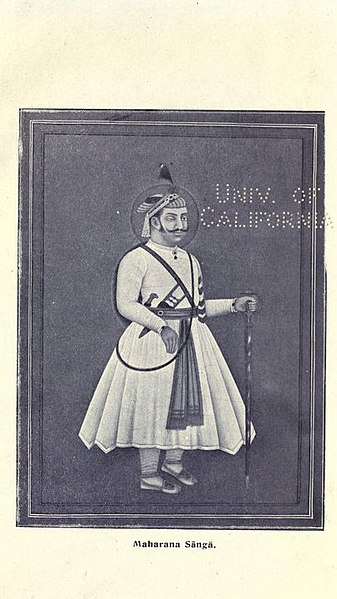A Warrior Who Defied the Mughals

In the early 16th century, India witnessed an unprecedented clash between two great powers: the Rajputs of Mewar, led by Maharana Sangram Singh I (Rana Sanga), and the emerging Mughal Empire, led by Babur.
🔥 Rana Sanga was not just a king; he was a warrior who embodied Rajput valor.
⚔️ With a deep understanding of warfare, he united Rajput clans against the Mughals.
🏹 Despite multiple wounds in battle, he refused to surrender and fought till his last breath.
This blog explores Rana Sanga’s battle strategies, his key military tactics, and how his legacy shaped Rajput warfare for generations.
1️⃣ The Rajput Confederation: Uniting the Warrior Clans
One of Rana Sanga’s greatest military achievements was uniting several Rajput kingdoms to form a confederation against foreign invaders.
📜 Before Rana Sanga: Rajput clans often fought among themselves, weakening their overall strength.
🛡️ Under Rana Sanga: He convinced rulers of Marwar, Amber, Jaisalmer, and Bundi to form an alliance against the Mughals.
👉 This strategic unity was a game-changer. Instead of fighting independently, the Rajputs combined their armies, resources, and war strategies, making them a formidable force.
2️⃣ The Guerrilla Warfare Tactics Against the Mughals

Unlike the Mughals, who relied on large armies and heavy artillery, Rana Sanga often used guerrilla warfare tactics.
🦅 Hit-and-Run Attacks – His cavalry would swiftly attack the Mughal camps and retreat before counterattacks.
🏹 Ambushes in Dense Terrain – He used the rugged Aravalli hills to his advantage, luring Mughal forces into surprise ambushes.
🏰 Fortress Warfare – Rajput forts like Chittorgarh and Ranthambore served as strongholds where Rajput warriors defended against prolonged Mughal sieges.
👉 This strategy frustrated Babur, who struggled to match the Rajput warriors' speed and unpredictability.
3️⃣ The Use of War Elephants: A Psychological Weapon
Rana Sanga’s army heavily relied on war elephants, which played a critical role in his battles.
🐘 War Elephants as Tanks – Armored elephants charged into enemy lines, breaking Mughal formations.
🔥 Psychological Warfare – Mughal horses would panic at the sight of massive, charging elephants.
⚔️ Mounted Archers on Elephants – Skilled archers rained arrows from an elevated position, striking Mughal troops at long distances.
👉 This gave Rana Sanga a tactical edge, especially in open battles.
4️⃣ The Battle of Khanwa: Rajput Bravery vs. Mughal Cannons

📅 Year: 1527
📍 Location: Khanwa (Near Agra)
After defeating Ibrahim Lodi in the First Battle of Panipat (1526), Babur aimed to establish Mughal rule in India. However, Rana Sanga stood as the final obstacle in his path.
Key Strategies of Rana Sanga in the Battle of Khanwa
⚔️ Mass Cavalry Charge – He used Rajput shock cavalry to break Mughal ranks.
🔥 Flanking Tactics – His warriors attacked Mughal forces from multiple sides.
🐘 War Elephant Offensive – His elephants stormed Babur’s frontlines, causing heavy casualties.
Why Rana Sanga Lost the Battle
Despite his bravery, Rana Sanga was defeated at Khanwa due to:
🧨 Babur’s Gunpowder & Cannons – Mughals introduced advanced artillery, which Rajput warriors were not prepared for.
☠️ Internal Betrayal – Some Rajput chiefs abandoned the battlefield, weakening his forces.
💨 Babur’s Psychological Warfare – Before the battle, Babur spread rumors that he was fighting a holy war (Jihad), which boosted Mughal morale.
👉 Though he lost the battle, Rana Sanga’s resistance forced the Mughals to recognize the Rajputs as a serious threat.
5️⃣ The Legacy of Rana Sanga’s Battle Strategies

Even after his defeat, Rana Sanga’s military tactics influenced future Rajput warriors.
⚔️ Maharana Pratap used similar guerrilla warfare against Akbar.
🏰 Rajput strongholds like Chittorgarh remained defiant against Mughal expansion.
🛡️ The Rajput confederation concept inspired later rebellions against foreign rulers.
Rana Sanga never surrendered—even on his deathbed, he was planning to attack Babur again. This unbreakable Rajput spirit became a defining trait of Mewar.
Conclusion: A Warrior Who Refused to Bow Down
Rana Sanga’s battle strategies proved that a determined warrior can challenge even the most powerful empire. His tactics of guerrilla warfare, cavalry dominance, and psychological warfare made him a Rajput legend.
💬 What do you think of Rana Sanga’s battle tactics? Comment below! 👇


